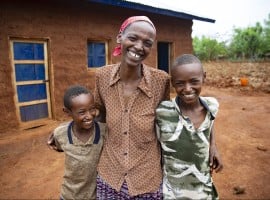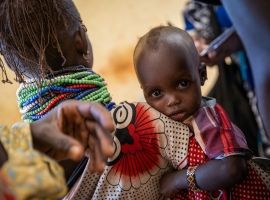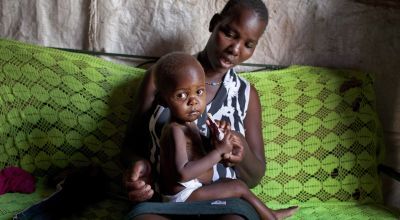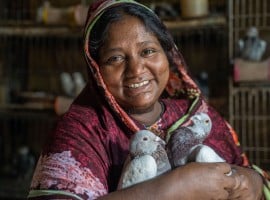
Read our 2024 annual report

Knowledge Hub
These 10 questions are among the most frequently asked about malnutrition and global hunger.
When we talk about global hunger, we’re really talking about malnutrition. It’s one of the key effects of hunger when it becomes chronic, and it’s one of the most fatal conditions, especially for children under the age of five.
Ending hunger and malnutrition in all its forms is one of the UN’s Sustainable Development Goals. We’ve begun to make progress on this front after a few years of losing ground due to the threats of COVID-19, climate disasters, and conflict. Even so,, there are still 512 million people expected to be facing hunger by 2030 (the deadline for meeting all of the SDGs) — nearly 60% of whom will be in Africa.
Ending malnutrition isn’t just one of the SDGs, it’s a key to achieving all of them. Every euro spent on reducing child malnutrition returns nearly €20 on that investment. Beyond that, it saves lives. With that in mind, here’s what you need to know about malnutrition.
What is malnutrition?
Malnutrition is a clinical condition that covers undernutrition, overnutrition, and specific micronutrient deficiencies.
-
Undernutrition is when a person doesn’t get enough energy and nutrients to maintain their normal activity and support the growth and development of their body.
-
Overnutrition (also referred to as overweight or obesity) is when a person gets too much energy and nutrients relative to what their body needs to function.
-
Micronutrient deficiencies are when a person doesn’t get enough of one (or several) specific nutrients, including vitamins and minerals that our bodies need to function.
Taken together, these three conditions are the single-largest contributor to disease.
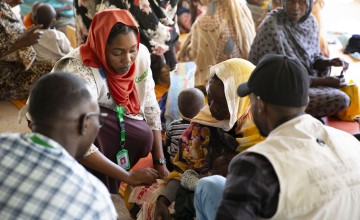
What is the difference between undernourishment and malnutrition?
Undernourishment or undernutrition is one type of malnutrition. Under that umbrella, there are also a few types of undernourishment. The two main types of undernutrition are acute malnutrition and chronic malnutrition.
What is acute malnutrition?
Acute malnutrition is also known as wasting, and means a low weight relative to a person’s height. It’s caused by a lack of nutritious food and/or repeated infections (which often become more frequent because of a weakened immune system due to undernutrition). Diagnoses are broken up between moderate acute malnutrition (MAM) and severe acute malnutrition (SAM).
This is an especially fatal condition for children, who are 12 times more likely to die if they have acute malnutrition. Acute malnutrition is treatable, but even one instance of it can have lifelong impacts on a child’s physical and cognitive development.
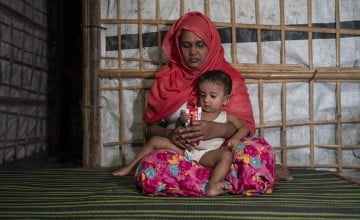
What is chronic malnutrition?
Chronic malnutrition is also known as stunting, and means a low height relative to a person’s age. This is the result of long-term (or chronic) undernutrition during childhood. Unlike acute malnutrition, stunting isn’t curable — it can only be prevented or managed, and can also carry a lifetime of consequences.
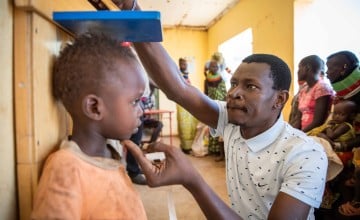
What other types of malnutrition are there?
Two common conditions associated with severe acute malnutrition are kwashiorkor and marasmus.
Kwashiorkor is caused specifically by a protein deficiency even if a person is otherwise receiving adequate calories otherwise. One of the key symptoms of kwashiorkor is edema, when fluid gathers in the legs, feet, and bellies, making them look swollen.
Marasmus is when a person has both a lack of calories and protein. In this case, there is usually no edema, and a person’s fat reserves will also go away, making their ribs visible as the condition worsens.
What are the symptoms of malnutrition?
There are a number of different warning signs for malnutrition in both children and adults. Some of the most common include unintentional weight loss (5-10% of your body weight within 3-6 months), a reduced appetite and lack of interest in food/drink, feeling tired and weak all the time, getting ill often and needing a long time to recover, and feeling low, tired, or even depressed.
What we most often see with children are variations on the above: rapid weight loss or difficulty gaining weight, lethargy, a lack of responsiveness, and other illnesses that aren’t going away.
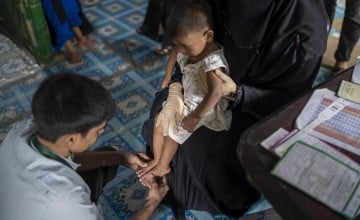
How is malnutrition diagnosed?
There are several ways of diagnosing malnutrition, and often it depends on what we’re screening for. While the BMI (body mass index) isn’t a perfect system, a person’s weight relative to their age and height is still one of the key ways we look for issues with nutrition.
At Concern, we more often come up against undernutrition or micronutrient deficiencies. We diagnose the latter most often through blood testing. To manage the former, especially in areas that are further removed from healthcare centres, we often rely on community health workers (CHWs).
As part of our Community Management of Acute Malnutrition programme, CHWs (and sometimes even parents themselves) can screen children for acute malnutrition without even needing a scale. To do this, we measure their mid-upper arm circumference (MUAC) with a plastic strip that gives a clear colour indication: Green (12.5 cm or more) is a healthy MUAC measurement, yellow (between 11.5 and 12.5 cm) is an indicator of moderate malnutrition, and red (11 cm or less) is an indicator that the child may be severely malnourished.
To measure chronic malnutrition or stunting, children are measured by height, which is then compared to the World Health Organisation’s Child Growth Standards. If their height-for-age is more than two deviations below the standard, they are stunted.
How is malnutrition treated?
Children who are severely malnourished often lose interest in eating (the same goes for adults). They may be admitted to a clinic for a feeding tube, but often we are also able to treat malnutrition through a form of outpatient therapy that is also part of the CMAM process.
Ready-to-use therapeutic food or RUTF, often known by the brand name Plumpy’Nut, is a nutritionally-fortified peanut paste that is prescribed as a course of treatment for children. Shelf-stable, portable, and easy to eat, it’s an effective alternative to in-patient treatment with a high cure rate that has saved millions of lives since it was introduced as part of the CMAM programme in 2000. (You can learn more about Concern’s involvement in the first CMAM pilot here.) During treatment, children are monitored by their caregivers and CHWs, with their MUAC progress and weight tracked.
Another group at high risk for malnutrition are expectant mothers, who require additional vitamins and minerals during their pregnancy. We work with mothers suffering malnutrition by giving them necessary supplements and fortified foods (particularly flour) to ensure that they get the nutrients that both they and their baby need.

Can we prevent malnutrition?
The challenge, however, is not just treating malnutrition when it happens, but being able to prevent it from happening in the first place. This goes in hand with tackling the specific causes of hunger in different communities.
In our work to fight hunger, Concern has found that there are times of the year in many countries and communities where cases of malnutrition spike — often during the lean season between harvests or a prolonged natural disaster like a drought. Our Health Surge programme, which began as an iteration on CMAM but now covers many childhood illnesses, is aimed at fighting hunger before it starts by monitoring health centre data, weather and other external factors, and sharing information and resources with communities.
This is a small approach to a large problem, and it’s not the entire answer. But it’s an important one: When we only focus on treating malnutrition, we’re really just responding to hunger crises that are already underway. It’s more cost effective to prevent versus cure, which is where approaches like Surge come in.
Can we end malnutrition?
Every single country in the world struggles with some form of malnutrition. Hunger in particular is one of the greatest issues of our time, and one where we’ve begun to lose progress in the last five years.
The real issues that keep hunger and malnutrition a constant threat are going to require international cooperation to sustainably and successfully resolve. That includes political action to end conflicts, international investment in climate adaptation, and means of holding leaders and decision-makers to account when making these commitments.

But change also happens in increments, and the more steps we take towards progress, the better. A quarter of a century after co-piloting CMAM (which is now the gold standard for treating malnutrition around the world), we continue to work with communities to develop innovative and effective programmes that help build resilience against the known-unknowns that are faced every day.
Last year, we reached 5 million people in 16 countries with our health and nutrition programmes. Your support can help us reach even more in the year to come.
